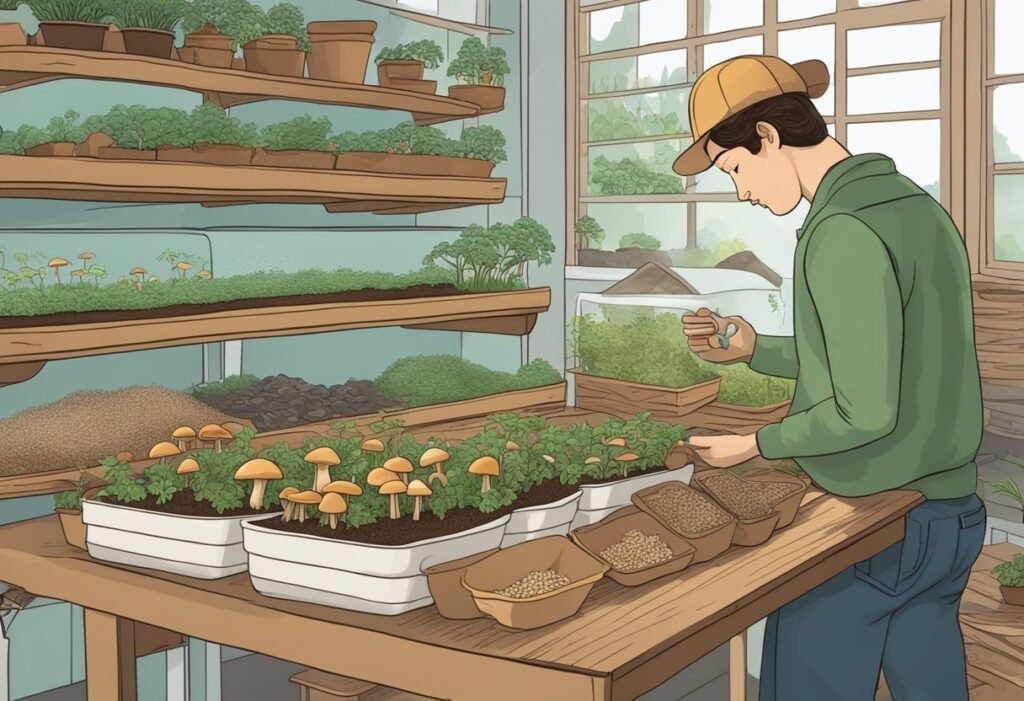Crimini mushrooms, also known as baby portobello mushrooms, are a delicious and nutritious addition to any diet. They are often used in Italian and French cuisine and can be found in most grocery stores. However, growing them at home can be a rewarding experience and save you money in the long run.
To grow crimini mushrooms, it is important to understand their growing conditions. According to ShunCy, they thrive in cool temperatures between 55-65°F (13-18°C) and require a consistent temperature throughout the growing process. They also grow on composted material, making them a secondary decomposer to other organisms that break down the matter first. Many other mushrooms grow on dying or dead wood and could be grown on logs at home.
Fortunately, growing crimini mushrooms at home is not as difficult as it may seem. With the right care and attention, you can easily cultivate your own crimini mushrooms in the comfort of your own home. In this article, we will provide you with a comprehensive guide on how to grow crimini mushrooms, including the supplies you will need, the growing process, and tips for maintaining healthy mushroom development.
Understanding Crimini Mushrooms

Species Overview
Crimini mushrooms, also known as baby portobello mushrooms, are a type of edible mushroom that belongs to the same species as the white button mushroom (Agaricus bisporus). They are characterized by their brown caps and firm texture, which makes them a popular ingredient in many dishes.
Crimini mushrooms are native to Europe and were first cultivated in the late 19th century. They are now widely grown in many parts of the world, including North America, Asia, and Australia.
Nutritional Benefits
Crimini mushrooms are a rich source of nutrients and have many health benefits. They are low in calories and fat, making them an ideal food for people who are trying to lose weight. They are also a good source of protein, fiber, and vitamins such as B vitamins and vitamin D.
In addition to their nutritional benefits, crimini mushrooms have been found to have anti-inflammatory and antioxidant properties. They may also help to boost the immune system and reduce the risk of certain diseases, such as cancer and heart disease.
Overall, crimini mushrooms are a delicious and nutritious ingredient that can be used in a variety of dishes. Whether you are a beginner or an experienced mushroom grower, learning how to grow crimini mushrooms can be a rewarding experience.
Preparation for Cultivation

Choosing the Right Substrate
Before starting the cultivation of crimini mushrooms, it is important to choose the right substrate. The substrate is the material on which the mushrooms will grow. Crimini mushrooms can be grown on a variety of substrates, including compost, straw, sawdust, and wood chips.
Compost is a popular substrate for growing crimini mushrooms. It is rich in nutrients and provides an ideal environment for mushroom growth. Straw is also a good substrate, but it requires more preparation. Sawdust and wood chips are less commonly used, but they can be effective if properly prepared.
Creating the Ideal Environment
After choosing the substrate, the next step is to create the ideal environment for mushroom growth. Crimini mushrooms require specific conditions to grow, including temperature, humidity, and light.
The ideal temperature for growing crimini mushrooms is between 55 and 65 degrees Fahrenheit. The humidity level should be around 70-80%. To maintain the necessary humidity levels, mist the growing area regularly or use a humidifier.
Light is not essential for mushroom growth, but it can help stimulate the growth process. Crimini mushrooms require indirect light, so it is best to place them in a location with some natural light but not direct sunlight.
In summary, choosing the right substrate and creating the ideal environment are crucial steps in preparing for the cultivation of crimini mushrooms. By following these steps, growers can create the optimal conditions for mushroom growth and increase their chances of a successful harvest.
Planting and Care
Spore Selection and Planting
Before planting, one should select the right spores for crimini mushrooms. The spores can be purchased online or from a local nursery. It is recommended to choose a strain that is suitable for the growing conditions in the area. The spores can be planted in a growing medium made up of a mixture of compost, straw, and gypsum. The mixture should be prepared by thoroughly mixing the ingredients.
The spores should be sprinkled over the surface of the growing medium and covered with a layer of peat moss. The container should be covered with a humidity dome or plastic wrap to create a moist environment. The container should be placed in a warm, dark area to allow the spores to germinate. After a few days, small white patches will appear on the surface of the growing medium, indicating that the spores have germinated.
Watering and Temperature Control
Crimini mushrooms require a lot of moisture to grow. The growing medium should be kept moist but not wet. Overwatering can cause the mushrooms to rot. The container should be misted regularly to maintain the necessary humidity levels. It is also recommended to use a humidity dome or cover to create a moist environment.
Crimini mushrooms prefer a temperature range of 65-75°F (18-24°C) and high humidity levels of around 70-90%. The container should be placed in a warm, dark area to allow the mushrooms to grow. Adequate ventilation is also important to prevent the growth of mold and other fungi.
Dealing with Pests and Diseases
Crimini mushrooms are susceptible to pests and diseases, particularly if the growing conditions are not optimal. The most common pests include mites, flies, and slugs. The best way to prevent pests is to maintain a clean growing environment and to avoid overwatering. If pests are detected, they can be removed by hand or with a natural insecticide.
Diseases can also be a problem for crimini mushrooms. The most common diseases include mold and root rot. The best way to prevent diseases is to maintain a clean growing environment and to avoid overwatering. If diseases are detected, the affected mushrooms should be removed immediately to prevent the spread of the disease.
Harvesting Crimini Mushrooms
Identifying Harvest Time
The best time to harvest crimini mushrooms is when the caps are fully grown and have opened up, but before the gills start to turn dark. This is usually when the mushroom cap is about 1-2 inches in diameter. You can also tell if the mushroom is ready to harvest by gently pressing on the cap. If it feels firm and doesn’t leave an indentation, it’s ready to be picked.
It’s important not to wait too long to harvest the mushrooms, as they can quickly become overripe and start to release spores. This can make the mushrooms less tasty and reduce their shelf life.
Harvesting Techniques
When harvesting crimini mushrooms, it’s important to use a clean and sharp knife or pair of scissors. Cut the mushroom stem as close to the substrate as possible, without damaging the surrounding mycelium. This will help to ensure that the remaining mycelium will continue to produce more mushrooms.
It’s also important to handle the mushrooms gently, as they can bruise easily. Avoid twisting or pulling on the mushrooms, as this can damage the mycelium and reduce future yields.
After harvesting the mushrooms, it’s a good idea to clean them gently with a damp cloth or paper towel to remove any dirt or debris. Avoid washing the mushrooms under running water, as this can cause them to become waterlogged and reduce their flavor and texture.
Overall, harvesting crimini mushrooms is a simple process that requires a bit of patience and attention to detail. By following these tips and techniques, you can ensure a bountiful and delicious harvest of these tasty mushrooms.
Post-Harvest Processing
Cleaning and Storage
After harvesting the crimini mushrooms, it is important to clean them properly to remove any dirt or debris. The mushrooms should be gently wiped with a damp cloth or paper towel to remove any dirt or debris. It is important not to wash the mushrooms as they will absorb water and become slimy. Once the mushrooms are cleaned, they should be stored in a cool, dry place. The ideal temperature for storing mushrooms is between 34 and 38 degrees Fahrenheit. The mushrooms should be stored in a container that allows for air circulation, such as a paper bag or a container with holes in it.
Packaging and Marketing
When it comes to packaging the crimini mushrooms, it is important to use packaging that will keep the mushrooms fresh and protected during transport. The mushrooms should be packaged in a container that allows for air circulation, such as a vented plastic container or a paper bag. It is also important to label the packaging with the type of mushroom and the date it was harvested.
When marketing the crimini mushrooms, it is important to emphasize their unique flavor and versatility in cooking. They can be used in a variety of dishes, including soups, stews, and stir-fries. It is also important to market the mushrooms as a healthy food choice, as they are low in calories and high in nutrients such as vitamin D and potassium.
Overall, proper post-harvest processing is important for ensuring the quality and freshness of the crimini mushrooms. By following these tips for cleaning, storage, packaging, and marketing, growers can ensure that their mushrooms are of the highest quality and appeal to a wide range of consumers.




